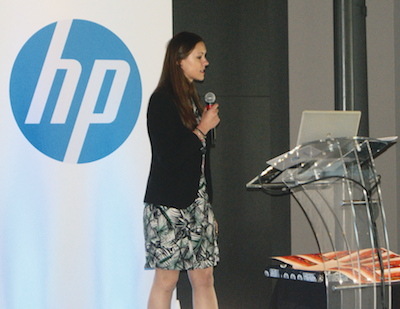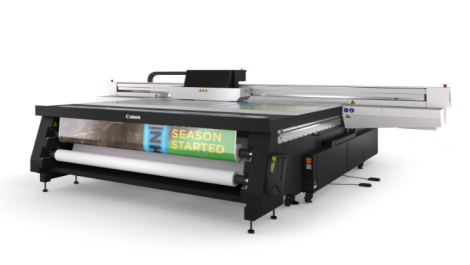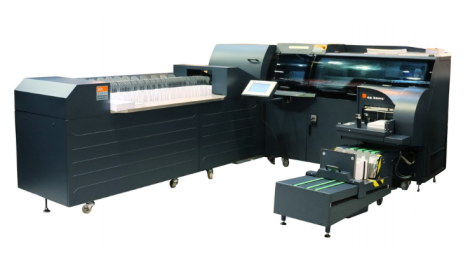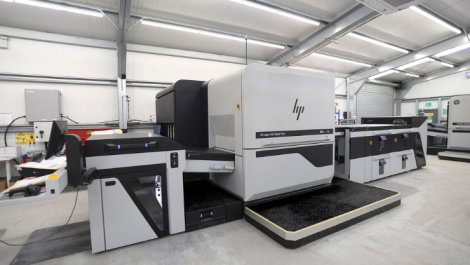Oana Manolache, HP’s UK & Ireland marketing manager
HP celebrated Prime Group’s entry to the HP Indigo 10000 club with an open house event in Nottingham where guests were treated to a series of presentations. Digital Printer’s Michal Lodej was given exclusive access to the event.
The stylish Dakota Hotel in Nottingham, close to Prime Group’s premises, was HP’s choice of venue to entertain existing and prospective customers, and it proved more than enough to draw in the crowds. Ian Kimber HP’s UK & Ireland country manager, commented: ‘It’s difficult to get busy printers away from their business, but here we are with a sell-out crowd. It must be the Nottingham effect.’
The event began with a conference on the trends in the market, technology and successful marketing campaigns made possible by digital print.
Oana Manolache, HP’s UK & Ireland marketing manager, started with a look at the wider part print can play in a digital world. She said: ‘The industrial revolution of the 19th century changed the world, and the cloud has that same potential. Over two billion people are online and this is growing. Facebook alone has one billion users and mobile users make up more and more of media consumption. Print has also changed, however; it has now become more valuable.
‘Royal Mail commissioned a study to show that direct mail has an emotional affect on the people who receive it. However, in the printing world we need to recognise the other media streams that marketers will use, so here is the opportunity for digital print to bridge the gap between paper and the online world.’
When it comes to seizing that opportunity it often falls to the brand owners and creative agencies that commission printed collateral to know the effective ways to use print. Ms Manolache divided up the print production chain into three groups: brands, creatives and producers.
She added: ‘At HP we look at what brands want, and what they want is ROMI – return on marketing investment. Creatives want to surprise customers with new effects, and producers simply want to meet the demands being asked of them.
‘We aim to show brands and creatives what is possible in terms of adding value and what can help to engage with customers. It’s a ‘me’ world with social media and personalisation products all centred on individuals, and we help them to encourage consumers to engage with them.
‘Brands know everything about us and we need to embrace this fact, that it can even be a benefit to us as consumers.’
Guest speaker Rachel Aldighieri from the DMA (Direct Marketing Association) said: ‘Marketing sits at the back of the printing process, now it needs to be involved throughout. What’s interesting is we found that 88% of [DMA] practitioners want to use direct mail to drive customers to the web, which can be done in a number of different ways. But what was most interesting is that a lot of agencies think that what print can do is waiting in the future; but it’s not, we can do these things already and we need to champion our capabilities.
‘An important revelation in our industry is getting away from the numbers and instead investing in the emotional response to print. We launched a new code of practice to our members recently; we changed it so the customer is at the start of everything.’
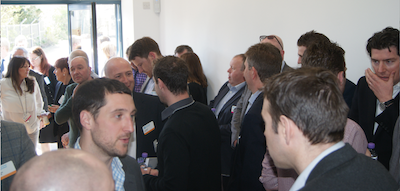
Give them what they want
Starting with the customer first…it was that very thought that eventually led Prime Group to add the B2-format HP Indigo 10000 to its printing arsenal. Jon Tolley, Prime Group managing director, took to the stage to tell the company’s story, which involves a long standing affinity with the HP Indigo range.
He said: ‘We’ve gone through the whole range of HP presses, including the 5000 and the 7000. It wasn’t long before we decided that the capacity wasn’t enough and we went for a 7500. Us printers love our shiny things, our pieces of kit and our new toys, and when we went to drupa in 2012 we saw this B2 press and signed up straight away. However, when we got back we had a think about the numbers, and they were very high, but more importantly we had to think about what it will do for the customer. I nearly ended up talking myself out of it. It was a tough decision to make, but we went for it. Since then opportunities have opened up, helping us to find new areas which we could never have done without the 10000.’
Erik Brammer, product manager for cut sheet presses at HP Indigo, also spoke to offer some technical information on the 10000. He told guests: ‘Customers can expect what I would call the Indigo basics: the same print quality, substrate gamut and gloss quality that they would expect from other Indigo sheet fed presses. The second thing is that with the B2+ sheet size, customers can impose more efficiently with a throughput of up to six times more than a smaller press. The unit also brings the intersection between a B2 sheet size and digital capabilities, which did not exist before this machine was made.’
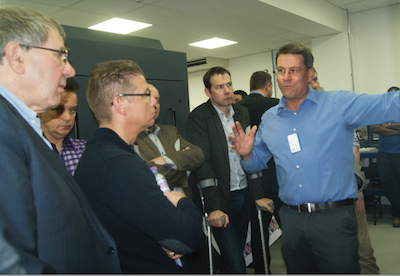
Erik Brammer speaking to customers
A few of HP’s partners were also present at the event, each giving their own presentation. Lee Ward, sales director of Tharstern, spoke about what printers need from a modern day MIS: ‘You need to know where your costs are and you need to know where your bottlenecks are to help streamline your business. Today MIS needs to be smarter with the least amount of touch points between staff and a job.’
Tracy Dineen, strategic alliance manager at Duplo International, spoke about the importance of finishing. She said: ‘Without finishing there is no product and it helps turn a product into profit. People are focused on the speed of the press, which is irrelevant as the production can only go as fast as the slowest part of the workflow, which usually is the finishing. We constantly look at key questions for print businesses: how can we make more money? How can we save money? And how do we find opportunities to move everything in house?’
After a a short bus ride from the hotel to the Prime Group facilities, guests were shown around the production room and came up close with the HP Indigo 10000.
The printer can run at 3450 sheets per hour in standard mode and up to 4600 sheets per hour in EPM (enhanced productivity mode), with a maximum paper size of 750 x 530 mm and a media thickness of 3 to 18 pt.
The machine is capable of printing at a resolution of 812 and 1219 dpi at 8-bit, with up to seven ink stations for the extended colour gamut, including HP Indigo ElectroInk White and other special effects inks. Colours supported as standard are cyan, magenta, yellow and black HP IndiChrome, plus orange, violet and green for seven colour printing.
Adrian Tolley, production director, talked guests through the company’s experience of the 10000 so far. He said: ‘It was an easy fit for us. It settled down well and hit the ground running, just flying through sheets for weeks, which is a bit of a double edged sword. Usually you would use the first few weeks to tweak the press and get to know how it runs. Now we have really started to learn about the press, which we should have done in the first few weeks, but it was going so well we didn’t want to stop it.’
HP is obviously very pleased that Prime Group is able to show off the capabilities of its B2 press. Lyle Rainey, HP’s UK & Ireland business development manager, described the company as a ‘visionary’, adding: ‘They understand how print is evolving, and they will secure the future of print against competition from the various other communication media.’
